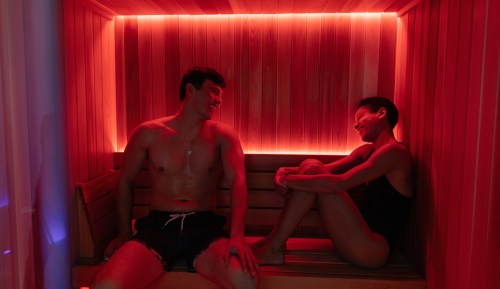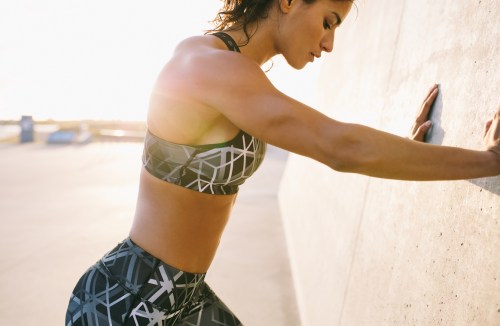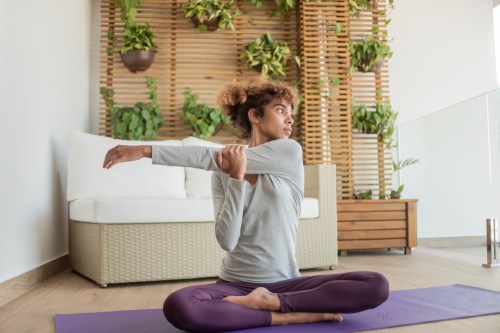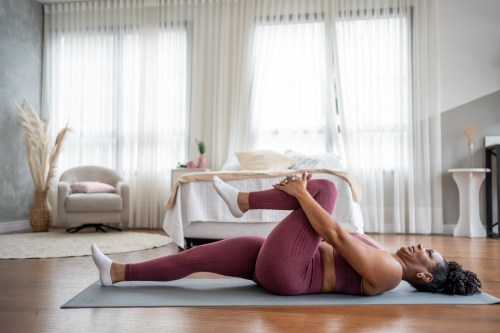‘I’m a Physical Therapist, and This Is the No. 1 Muscle Affected by Winter Stiffness’
Shivering and tensing up is the body’s natural response to uncomfortably low temperatures, and that can cause trapezius tightness.

Winter stiffness can be a real pain in the neck (literally). According to physical therapists, it’s common for your neck and shoulders to tighten up this time of year, which can lead to a lot of pain and discomfort. The most common area affected? Your trapezius muscles, aka the “traps.” These pesky muscles extend from the base of your neck to the middle of your back, spanning across your shoulders.
Experts in This Article
physical therapist
Brandon Marét is a physical therapist at Coast Physical Therapy in La Jolla, California
Ashley Taylor, DPT, a physical therapist at Coast Physical Therapy in La Jolla, California, explains that shivering and tensing up is the body’s natural response to uncomfortably low temperatures. “When you shiver and feel cold, you may tend to shrug your shoulders up,” she says. Check in with yourself—are you doing that right now?
Shrugging and shivering can lead to tension in the traps and the muscles that attach to the lower part of your skull. “There are a lot of connected muscles in that region that can be affected,” says Taylor. And this tension, in turn, can cause pain, inhibited movement (i.e., you can’t turn your head in certain directions), and, in some cases, severe headaches. All from being cold!
Fortunately, there are a few ways to find relief. Taylor and her colleague at Coast Physical Therapy, Brandon Marét, a physical therapist assistant, share their top three techniques for alleviating shoulder and neck stiffness—winter or otherwise.
How to alleviate trapezius tightness
1. Try the ear-to-shoulder upper trap stretch
One move you may be familiar with is the top recommendation from both PTs: the ear-to-shoulder gentle neck stretch. “This stretch helps to release some tension from the sides of the neck and upper trapezius muscles,” says Taylor.
It’s relatively straightforward: Bring your right ear toward your right shoulder, using your right hand to gently pull your head a bit closer. Be mindful not to pull too hard! For a demo, start the below video at around 40 seconds.
Marét says to keep the opposite shoulder low. He suggests holding onto the seat of your chair or whatever you might be sitting on to get more of a stretch. “If you don’t have anything to hold onto, depress the opposite shoulder by bringing that hand behind your back,” he says.
Hold this position for a few deep breaths, and switch sides.
2. Indulge in some myofascial release
“One of my favorite ways to relieve tension in this area is with a lacrosse ball for some myofascial release,” says Marét. You can do this by pressing the ball between your traps and a wall. “Try moving it around the painful, more tense areas, pausing and holding onto those certain ‘feel good’ spots,” says Taylor. You’ll know when you get there! Hover over any tender areas for 10 to 15 seconds.
The pressure from this therapeutic tool can help reset that brain-body connection while loosening up the stiff muscles. Bonus: It’s a method that you can use on any part of your body, regardless of seasonal stiffness.
3. Work on everyday postural awareness
Lastly, Taylor says to use this chilly time as an opportunity to check in with your body more frequently. “Everyday postural awareness is a simple, free way to check in with your own body and develop a deeper connection with yourself,” she says. “Be conscious of your posture, mindful of your movement, and check in with how you’re feeling frequently.” Getting in tune with your posture and physical sensations may clue you into misalignments that could be the source of pain (like chronic headaches), which will allow you to get help from your PT or physician.
Feel your posture slipping throughout the day? Try this workout to help strengthen the muscles you need to stay properly aligned:
Taylor points out that it’s not just your neck and shoulders that can get tight and stiff during the cold months. “Also keep an eye out for your Achilles and your feet,” she says. “Cold ankles and feet can lead to tightness, which can impact how you walk.” That not only affects your posture from head to toe, but can also result in heel pain. So keep your feet (and other muscles) warm. And, of course, “make sure you check in with your physical therapist!”
Oh hi! You look like someone who loves free workouts, discounts for cutting-edge wellness brands, and exclusive Well+Good content. Sign up for Well+, our online community of wellness insiders, and unlock your rewards instantly.
Sign Up for Our Daily Newsletter
Get all the latest in wellness, trends, food, fitness, beauty, and more delivered right to your inbox.
Got it, you've been added to our email list.










